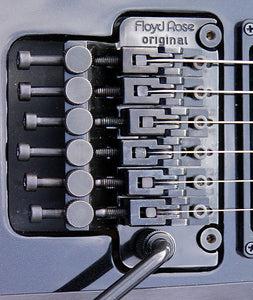Understanding the Floyd Rose Tremolo: Setup, Tuning, and Optimization
The Floyd Rose tremolo system is one of the most versatile and expressive guitar bridges ever designed, offering incredible tuning stability even under extreme whammy bar abuse. However, to get the most out of it, you need to understand how factors like string gauge, tuning stability, and bridge setup affect its performance.
1. String Gauge Matters
The string gauge you use plays a crucial role in how the Floyd Rose responds.
- Lighter gauge strings (e.g., 9-42, 9-46): Easier for bends and dive bombs but may feel too loose in lower tunings.
- Heavier gauge strings (e.g., 10-52, 11-56): Provide more tension, great for lower tunings, but require stronger springs to balance the bridge.
- Hybrid sets (e.g., 9-46 or 10-52): Offer a balanced feel between high and low strings, making them ideal for mixed playing styles.
If you change string gauge, you will need to adjust the bridge tension using the springs in the back cavity.
2. Choosing the Right Tuning
- Floyd Rose systems are typically set up for a specific tuning. Dropping to a lower tuning without adjusting the springs will cause the bridge to tilt forward.
- Standard E and Eb are common for most setups.
- Drop tunings (Drop D, Drop C, etc.) require careful balancing of the tension or the use of a D-Tuna (for standard-to-Drop-D switching on non-recessed bridges).
- If you use lower tunings frequently, consider a heavier string gauge and extra tension springs to maintain proper float and stability.
3. Recessed vs. Non-Recessed Floyd Rose
There are two main styles of Floyd Rose installation:
-
Recessed Floyd Rose:
- Sits lower in the body, allowing for both pull-ups and dive bombs.
- Requires precise balance to keep it floating level.
- More challenging to set up and maintain due to its sensitivity.
-
Flat-Mounted Floyd Rose:
- Sits flush against the guitar body, limiting upward movement.
- Generally more stable and easier to re-tune.
- Works well with a D-Tuna for quick drop tuning changes.
4. Spring Setup & Fine-Tuning Stability
- Most Floyd Rose systems use 3-5 springs in the back cavity, depending on string tension.
- Tighter spring tension keeps the bridge more stable but makes the bar stiffer.
- Looser spring tension allows for easier bar movement but can lead to tuning instability.
- Consider noiseless springs to reduce unwanted vibrations.
Final Thoughts
The Floyd Rose is an amazing tool for lead players, shredders, and dive bomb enthusiasts, but setup is everything. Whether you're going for crazy whammy bar tricks or stable tuning in drop tunings, getting the right balance between string gauge, spring tension, and bridge positioning is key.
Having issues getting yours set up perfectly? Feel free to reach out to us!

